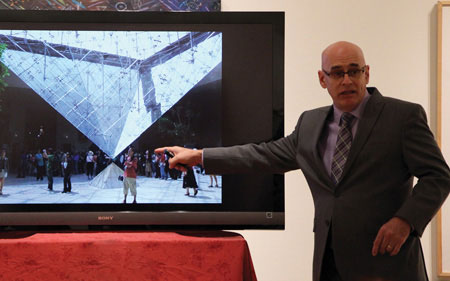
Each museum has a story of how it obtained its permanent collection, and rarely does it seem pieces are acquired by virtuous methods.
On April 30, the Triton Museum of Art’s Chief Curator, Preston Metcalf, began taking art lovers on a five-week journey through the sordid pasts of some of the greatest art museums in the world.
“Tonight,” said Metcalf “and for the next five weeks … We’re going Paris. We’re going to London; New York; Las Vegas. We’re going all over the place. We’re going to talk about some of world’s great art collections and the institutions that house them. What we are not going to do is go down the catalog of all the great works that these have in them. We’ll see some, but I’m interested in gossip. I’m interested in the interesting tales that lead to events that happened to cause these organizations, these institutions, to get their collections. So, tonight we’re going to start with the Louvre … What does Bernini’s mistress, Louis the IX’s legs, Napoleon’s penis and canned goods all have in common? The Louvre.”
To explain, Metcalf said the Louvre was once an art institution, with one of the first Baroque artists being Gian Lorenzo Bernini. While in residence, Bernini had his mistress, Costanza Piccolomini, beaten and raped.
Later, the Louvre was a vanity gallery for royalty – really starting with Louis the XIV utilizing the museum for paintings that showed off his legs. “We have countless paintings specifically collected, commissioned, displayed, just to show off his legs,” said Metcalf. “So, how about that? The Louvre was an early meat market.”
When Napoleon took over the Louvre, a “systematic art theft campaign is employed, and they took everything,” said Metcalf. Napoleon’s reign of terror was said to be partly due to, according to psychologists, his small penis.
Then there was the story of canned goods – or more like motion sensor steel walls.
If the sensor is triggered, “a one-inch sheet of steel is going to come down in blinding speed and wherever you’re standing [in the Mona Lisa alcove], it’s going right through you,” said Metcalf. “Should you be there at a time when a crime is perpetrated and you’re trying to run out, I would suggest that you don’t try to go through the main exits. They have the same sheets of steel that will come down like a cartoon anvil and slice you.”
These, of course, weren’t the only stories Metcalf told. The entire lecture was full of facts about the famed museum’s dark and unsavory history.
“It was built through greed, through crime, through massive egos,” said Metcalf. “The only time it was really coordinated for the people was during the revolution and that was only so they could lie to people. It wasn’t until we get to the nineteen to twentieth century that we really have a museum for the people.”
The lecture series continues on Thursday, May 7 with “The British Museum: Looting Ancient Greece.” Lectures begin at 7 p.m. Drop in fee is $20 per lecture. Visit http://tritonmuseum.org/education_adults_arthistory_fall2014.php for more information.
